|
How A German Flyer
Spent Part of His Life in a Tent |
|||||||||||||||||||||||||||||||||||||||||||||
|
The Flight
At
about 2145 hrs on 14th March 1944 a Junkers Ju88 S0 taxied
along the main runway of Melsbroek airfield NE of Brussels. To those who
watched it depart was visible it's unit designation on the side of the
fuselage, 3E+LS. On board, the pilot Unteroffizier
Hans Schönleitner eased open the throttles and the two
supercharged engines roared into life. Schönleitner was a 23 year old
Austrian, alongside him his Observer/co-pilot Unteroffizier
Helmut Baumgart watched the dark airfield disappear below them as
the aircraft climbed into the cold and windy night sky. He was the
"baby" of the crew, just 19 years old.
Behind
these two in the wireless position of the cramped cockpit was
Unteroffizier Alfons Harnisch. Further
along the fuselage in the airgunners position was the tall figure of
Gefreiter Gerhard Grünewald.
The
mission was bomb London, specifically Whitehall. In the bomb bay sat a
1000lb bomb and 10 50kg bombs. The 3E+LS was part of the 8 Staffel of
Kampfgeschwader 6, operating as pathfinders for other bombers at this
time.
During
the flight radio silence was kept, the weather conditions made
navigation a problem. The other worry was that they had been delayed
prior to take off. Schönleitner had the engines running at full boost
much of the time. They were caught in searchlights, the pilot took what
evasive action he could, he dived down the "beam" of the light
before veering off to one side or another. The strain on the engines was
telling.
As
they approached their target one engine failed. Schönleitner ordered
the bomb load to be jettisoned at once. Now the plane was a handful. All
at once the second engine caught fire and the pilot ordered the crew to
bale out. Local people recall the German bomber flying overhead, aflame from end to end. Hans Schönleitner was the last to leave the stricken aircraft, he jumped into the night. Shortly afterwards the 3E+LS was smashed to pieces as it hit the ground near the village of All Cannings in Wiltshire.
The Capture As daybreak broke on March 15th the villagers came to see the smouldering remains. The local Police, home guard and American service personnel had accounted for three of the four crew. Later that afternoon some schoolboys came across a prone figure lying in a field, about 2 miles from the impact area. One recounted to me, many years later how peaceful this young man looked, as though asleep. The only trace of violence being a trickle of blood from his mouth. Thus died Hans Schönleitner, his parachute having failed to deploy fully. In keeping the Ju88 flying, and allowing his crew to escape he had paid the price.
Today
he lies buried in Haycombe cemetery, Bath, England. He is not alone, as
he shares his resting place with several other German airmen. As you can see, the story does not end in England. For two of the 3E+LS their captivity takes them even farther afield, to America. This is just a brief outline of the story of one German bomber crew. This was their first, and last Feinflug!! The Trip to America This part of the story is only conjecture. The true details are not know. It is supposed the surviving crewmembers were quickly placed in a Prisoner-of-War camp in England. After interrogation and receiving medical treatment, they would have eventually been placed upon a ship bound for America. Probably arriving in the Port of New York, they would have been turned over to U. S. Army authorities, given another medical exam and placed in a temporary Prisoner of War camp in New York state. After a few days, they would have been loaded onto a heavily armed train and sent to their final destination. For Gefreiter Gerhard Grünewald, at least, that destination was the Internment Camp at Camp Atterbury, Indiana. Deep in the heartland of America.
Upon arriving at Camp Atterbury, the prisoners disembarked from the train cars under the watchful eyes of the train guards. An assembly and head count was immediately made, and a Post guard officer signed a receipt for the group of German prisoners. As one other German prisoner, Mr. Oskar Waggoner related, the group was hastily assembled into a loose formation. A Sergeant from the Camp Atterbury Guard detail would then read the roster of names, expecting to hear a loud "HEAR !" in return. Mr. Waggoner kept listing for his name to be called, which for all of his life had been pronounced "Vagner". The Sgt kept hollering "Wagoner" over and over. Finally, as he was the only one not accounted for, the Sgt. and the German finally figured out the problem. Mr. Waggoner recalls the Sgt. was pretty upset. After roll call, the prisoners were marched off to the Prisoner of War camp, perhaps one mile away, where they were fed a meal that surprised each man as to its quality and quantity. Then the were scheduled for another medical exam. Morristown, Indiana - Rural Shelby County After receiving the next medical exam, Gefreiter Gerhard Grünewald was quickly loaded upon a truck and sent 35 miles to the northeast, to the Branch POW Camp just outside of Morristown, Indiana. The camp was a small tent city, providing for approximately 50 prisoners, who would work in the Morristown Canning Factory for the duration of the war. Discovery In January 2001, Mr. Simon Herrald, of England, was "surfing" the Internet looking for information on German flyers that had crashed virtually in his front yard near the village of All Cannings in Wiltshire. To his surprise and delight, there on the Indiana Military web site (www.IndianaMilitary.org) he saw, for the first time in some 57 years, he saw the image of Gefreiter Gerhard Grünewald looking back at him. Contacting Jim West via Email, the identity was quickly confirmed. Mr. Harrold wrote the FLIGHT and CAPTURE portion of this story. As luck would have it, the webmaster, Jim West had attended a talk given in a Morristown church in 1998, by Mr. Oskar Waggoner. Mr. Waggoner and others in the community had assembled a small grouping of photos of the men working in the canning factory. One of the ladies responsible for hosting the meeting, Mrs. Pam Pherigo, was related to the owners of the Morristown Canning Factory. A few of the photos showed the German workers. It was copies of these photos, taken and placed on the Internet, that caught Mr. Harrold's attention. Alfons Harnisch is also on the list for Atterbury, but could not be found in the lists surviving.
In both photos above,
Gerhard
Grünewald is the tallest, on the right side of each.
Gerhard Grünewald is third from the rear of the column.
An oil painting by Gerhard Grünewald.
|
|||||||||||||||||||||||||||||||||||||||||||||

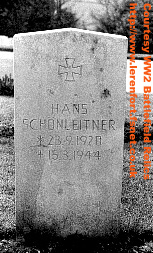
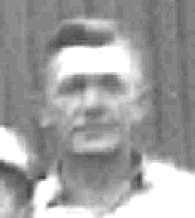
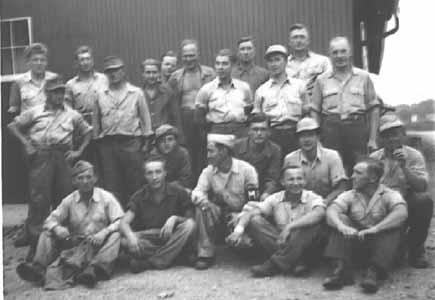
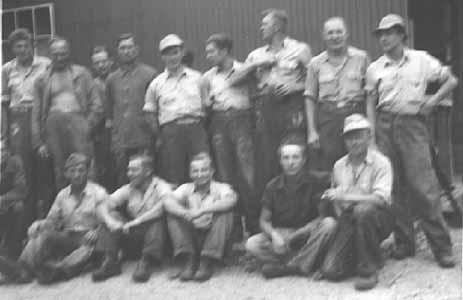
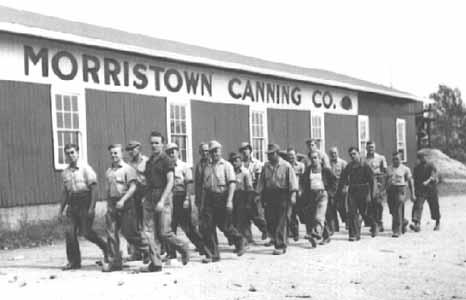

 Page last revised
09/01/2022
Page last revised
09/01/2022